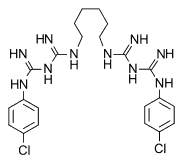A previous study revealed that iodine tincture for skin antisepsis was associated with a significantly lower rate of blood culture contamination than povidone-iodine. An explanation for a higher rate of contamination when povidone-iodine is used may be its slower rate of action. Povidone-iodine is preferred because of its lower rate of iodine toxicity. Chlorhexidine has been found to be superior to povidone-iodine and alcohol when it is used as a skin antiseptic for catheter placement, but its value in obtaining blood for culture remains uncertain. Mimoz and associates analyzed contamination rates between the chlorhexidine and povidone-iodine solutions used to cleanse the skin before blood specimen collection.
The authors speculated that the lower effectiveness of povidone-iodine as an antiseptic agent could be related to the time required to achieve antisepsis with this agent. Ideally, skin antisepsis should be achievable within a minimal amount of time. Hospital personnel may not wait long enough for povidone-iodine to take effect before drawing the blood sample. Accordingly, the authors investigated whether the use of chlorhexidine would lower the rate of blood culture contamination in a setting in which personnel did not consistently allow antiseptics to act for the recommended period before specimen collection.
The study was conducted in three intensive care units for adults. Patients who required blood cultures were randomly assigned to receive antiseptic applications of an alcoholic solution of 0.5 percent chlorhexidine gluconate or an aqueous solution of 10 percent povidone-iodine. Skin antisepsis was achieved by vigorously applying the assigned antiseptic solution once. Blood was obtained 15 to 30 seconds after the application.
Of the 2,041 blood cultures collected from 403 patients, 124 yielded pathogens: 45 cultures were interpreted as contaminated, 76 as truly positive and three as concomitantly contaminated and truly positive. The rate of blood culture contamination was 1.4 percent (14 of 1,019 cultures) when chlorhexidine was used to cleanse the skin compared with 3.3 percent (34 of 1,022 cultures) when povidone-iodine was used. This difference was statistically significant. Both groups were similar with regard to the incidence of true bacteremia and of sterile blood cultures. Coagulase-negative staphylococci were the most common organisms recovered, accounting for 98 percent of contaminants and 22 percent of true pathogens.
The authors conclude that chlorhexidine antisepsis reduces the rate of blood culture contamination. They note that chlorhexidine is effective against all nosocomial pathogens, and primary bacterial resistance is rare. Although the protein-rich biomaterial of the skin surface can neutralize the germicidal activity of povidone-iodine, proteinaceous material has little effect on the antibacterial activity of chlorhexidine. The authors point out that the efficacy of povidone-iodine solution may be improved if several minutes are allowed to lapse between application and venipuncture. However, with the usual short interval between application of an antiseptic agent and venipuncture, chlorhexidine appears to be more effective in reducing the rate of blood culture contamination.
RICHARD SADOVSKY, M.D.
Mimoz O, et. al. Chlorhexidine compared with povidone-iodine as skin preparation before blood culture: a randomized, controlled trial. Ann Intern Med December 7, 1999;131:834-7.
COPYRIGHT 2000 American Academy of Family Physicians
COPYRIGHT 2000 Gale Group



